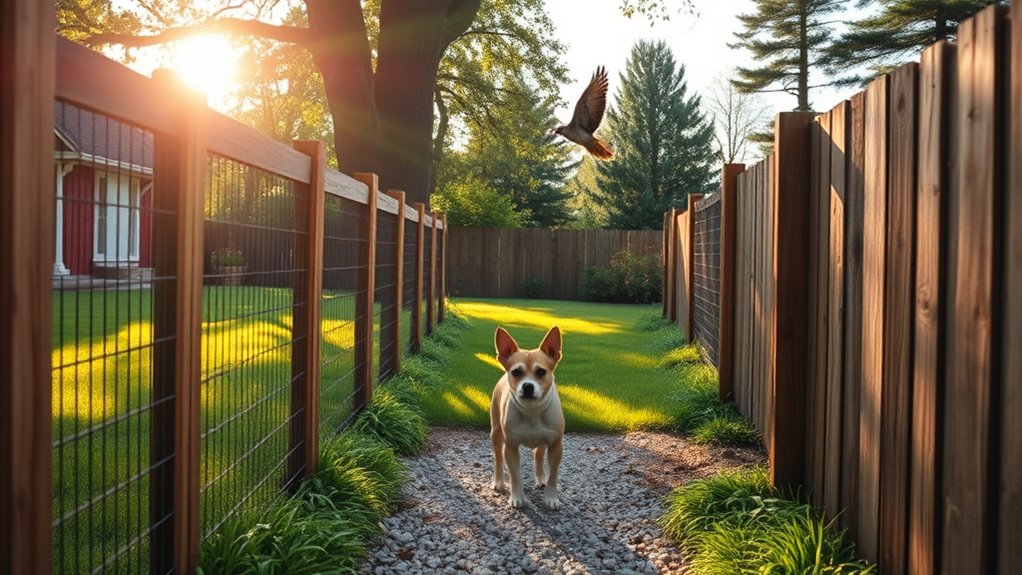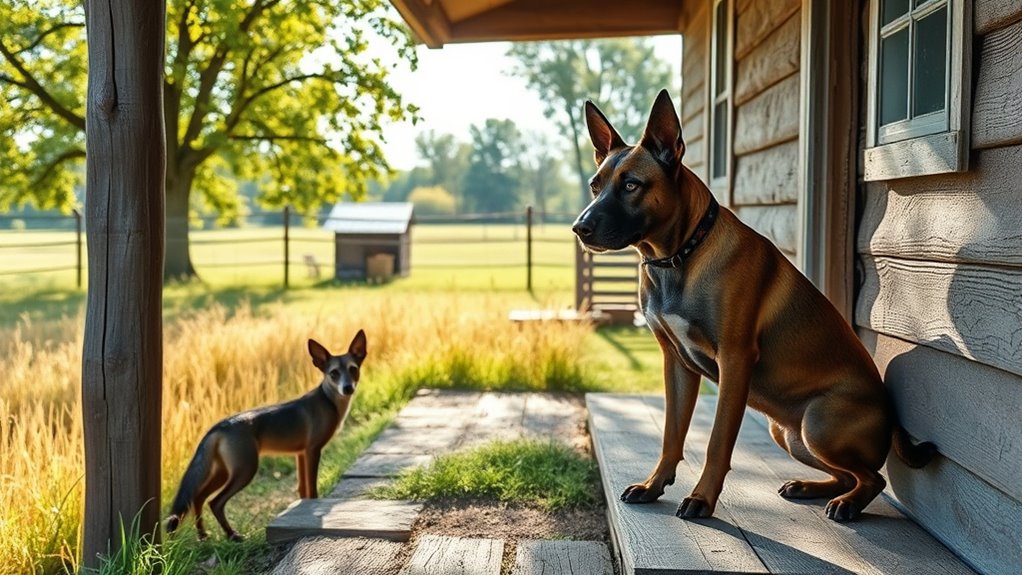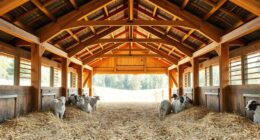To protect your pets from predators on the homestead, make certain you build sturdy fencing at least six feet tall and regularly check for gaps or holes. Work with neighbors to create cooperative fences that extend security and reduce costs. Use predator-proof enclosures with secure latches and buried fencing to prevent digging predators. Adding deterrents like motion-activated lights and supervision during dawn and dusk further minimizes risks. Keep your pets safe outdoors by combining physical barriers with vigilant oversight—discover more strategies to keep them secure.
Key Takeaways
- Install at least a six-foot-high, sturdy fence around outdoor areas to prevent pets from jumping or climbing out.
- Collaborate with neighbors to create a shared, secure fencing system that reduces gaps and weak spots.
- Use predator-proof enclosures with secure latches, heavy-gauge wire, and buried or overhanging fencing to deter digging and climbing.
- Add deterrents like motion-activated lights, alarms, or buried fencing to prevent tunneling and keep predators away.
- Always supervise pets outdoors, especially during dawn and dusk when predators are most active, to ensure continuous safety.

Pets are vulnerable to predators, especially when they roam outdoors or have limited supervision. If you want to keep your animals safe, investing in the right barriers is essential. One effective approach is installing cooperative fencing around your property. Cooperative fencing involves working with neighbors or community members to create a more extensive, secure boundary. It’s a smart way to strengthen your perimeter without bearing the entire cost alone. When everyone participates, it’s easier to prevent predators from slipping through gaps or weak spots. Make sure your fencing is tall enough, usually at least six feet, since many predators are capable jumpers or climbers. Also, check for any gaps or holes regularly; predators are resourceful and can exploit even tiny openings.
Beyond fencing, predator-proof enclosures are vital for safeguarding specific pets or vulnerable areas. These enclosures are designed with sturdy materials, often with secure latches and no gaps that predators can squeeze through. For example, a predator-proof chicken coop or small animal run can keep your poultry or rabbits safe during the night or when you’re not around. These structures are usually made from heavy-gauge wire or durable materials that resist attempts by predators to break in. When planning predator-proof enclosures, pay attention to ventilation, ease of cleaning, and secure doors. The goal is to create a space where your animals can be safely confined without the constant worry of a predator attack.
Predator-proof enclosures with sturdy materials and secure latches keep pets safe overnight.
You should also consider adding features like overhangs or buried fencing to prevent digging predators from tunneling underneath. Many predators, such as foxes, raccoons, and coyotes, are skilled diggers, so extending fencing underground or adding a concrete base can be highly effective. Additionally, you might install motion-activated lights or alarms to alert you if a predator gets too close. These deterrents can scare off potential threats before they reach your pets.
Finally, never underestimate the value of supervision. Even the best fencing and enclosures aren’t foolproof if pets are left unattended in vulnerable areas. Keep a close eye on them, especially during dawn and dusk when predators are most active. Combining physical barriers with vigilant monitoring creates a thorough defense against predators. By taking these steps—cooperative fencing, predator-proof enclosures, and consistent supervision—you notably reduce the risk of a predator attack. Your pets will thank you for the extra effort, allowing them to enjoy their outdoor time safely.
Frequently Asked Questions
How Can I Identify Signs of Predator Attacks on Pets?
You can identify signs of predator attacks on your pets by tracking signs like unusual behavior or injuries. Look for scent indicators such as a strong, unfamiliar smell around your pet or the area. Keep an eye out for bite marks, missing fur, or disturbed bedding. Tracking signs of recent activity, like footprints or scat, helps you determine if predators are nearby and if your pets have been targeted.
Are There Natural Deterrents to Keep Predators Away?
You can use natural repellents like strong-smelling herbs, garlic, or predator-specific scents to deter unwanted visitors. Fencing options such as sturdy wire or electric fencing also work well to keep predators at bay. Combining natural repellents with secure fencing creates an effective barrier, giving your pets safety and peace of mind. Regularly check and maintain these deterrents to guarantee they stay effective against persistent predators.
What Are the Legal Considerations for Protecting Pets From Predators?
Like a tightrope walker balancing carefully, you must navigate legal considerations when protecting your pets. Confirm your actions align with local laws, emphasizing legal compliance to avoid unintended consequences. Be mindful of liability concerns—if your methods harm others or damage property, you could face legal trouble. Know your rights and restrictions, and consult local regulations to keep your protective measures within the bounds of the law, safeguarding both your pets and peace of mind.
How Do Predator Behaviors Vary by Region or Species?
You should understand that predator behaviors vary by region and species. Regional predator patterns influence how animals hunt, with some species being more active at night or during certain seasons. For example, foxes may target small pets in rural areas, while raccoons are more common in urban regions. Recognizing species-specific behaviors helps you implement effective protection measures, ensuring your pets stay safe from local predators based on their unique habits and regional tendencies.
Can Livestock Guardian Animals Effectively Protect Pets?
Livestock guardian animals can effectively protect pets if you choose the right guardian breeds and implement proper fencing strategies. These breeds are naturally protective and can deter predators from approaching your pets. Ensuring your fencing is secure and predator-proof helps keep everyone safe. By combining guardian breeds’ instincts with sturdy fencing, you create a strong barrier that minimizes risks and promotes harmony among your pets and livestock.
Conclusion
Think of your pets as precious treasures hidden in a vast forest. Just as a wise guardian keeps watch, you must stay alert and proactive to shield them from lurking dangers. Guarding your animals isn’t just about fences or gadgets—it’s about being the steady, vigilant presence that guarantees they flourish safely. When you act as their steadfast protector, you create a safe haven where they can thrive, just like a forest where every creature plays a vital role.










